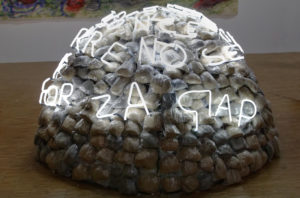
Mario Merz, Igloo di Giap (Giap’s Igloo), 1968, metal structure, wire mesh, bags of clay soil, neon, batteries, accumulators, 120 x 200 cm (Centre Georges Pompidou, Paris, photo: Yannick, CC BY-NC-ND 2.0)
North Vietnamese General Võ Nguyên Giáp said, “If the enemy masses his forces, he loses ground; if he scatters, he loses strength” to describe the perils one faces in battle. Regardless of the benefits gained from a military strategy, it could lead to other disadvantages. So why did the contemporary Italian artist Mario Merz include this statement on Igloo di Giap? What was he trying to say to the viewer of his work?
At first glance, Merz’s Igloo di Giap (translated as Giap’s Igloo) might confuse the viewer with its unusual appearance. It is a four-foot-tall igloo made from a metal frame covered with wire mesh on top of which are clear bags filled with clay soil. Across the surface of the igloo in white neon tubing is written the statement made by General Giáp translated into Italian: “Se il nemico si concentra perde terreno se si disperde perde forza.”
Arte Povera
To understand the meaning behind Merz’s Giap’s Igloo, we need to go back to 1968 when the work was made. At the time, Merz was associated with a group of artists known as Arte Povera. The term Arte Povera [poor art] was coined by the Italian art critic and curator Germano Celant to refer to artists who often exhibited together in the late 1960s though each worked in different styles, with diverse materials, and with varying concepts. One commonality they shared was that they each sought to bring life and art together. They encouraged viewers to actively engage with the artwork and experience underlying forces that we all respond to such as fire, gravity, electricity, or social and political tensions that existed in the present moment. Though these artists often utilized common, everyday “poor” materials such as glass, metal, stone, beeswax, and dirt in their work, this was not the basis for the term “Arte Povera.” Instead, Celant envisioned Arte Povera artists as stripping away—impoverishing—the codified ideas, words, and ideologies attached to traditional western culture to allow the viewer to have a more direct experience of art and life.
Merz and the other Arte Povera artists were responding to changes occurring globally. Many of these artists came of age after World War II, when the socio-economic landscape of Italy was rapidly transforming as it recovered from the devastation of the war. This was also a period of intense social upheaval. Students and workers united to protest unfair labor and education conditions. U.S. monetary aid sent to rebuild Europe’s economy helped to improve the production of material goods and repair infrastructure. At the same time, a new influx of American capitalist and consumer values was transforming Italian culture, which led many Italians to oppose U.S. influence, a reaction that was expressed through works of art. The U.S. military presence in Vietnam in the 1950s and 60s led to heightened hostility among Europeans who grew increasingly critical of the violence occurring abroad.
Arte Povera artists rarely created politically overt work; instead, they sought to create art that would provoke viewers to question the social and political systems and structures of the world around them. Within this context, it becomes clearer why Merz incorporated General Giáp’s statement onto his igloo. The phrase asks viewers to consider the actions being taken by Giáp and other Vietnamese during the Vietnam War, which had been ongoing for more than a decade when Merz created his sculpture. At the same time, Giap’s Igloo encourages viewers to contemplate their actions in the moment by encouraging them to physically engage with the object. As they walk around the work, they might consider how the words implicate them within larger cultural systems.
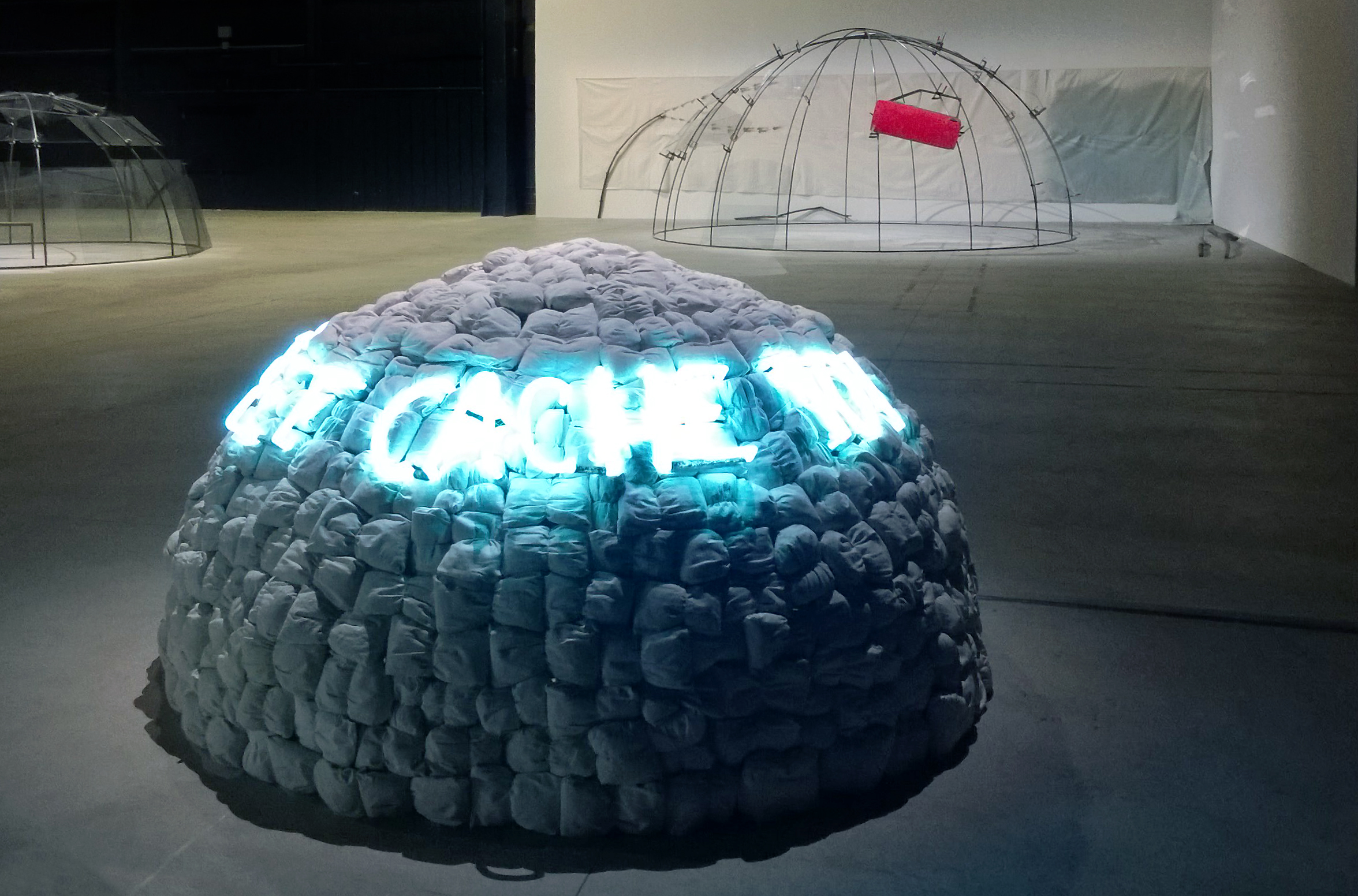
Mario Merz, Igloos, Pirelli Hangar Bicocca, Milano, 2018 (photo: CiaoMilano, CC BY-NC-SA 2.0)
Why an igloo?
Giap’s Igloo was the first igloo created by Merz. During his career, he made over 30 igloos in various sizes and with a variety of organic and industrial materials. An igloo is a basic architectural structure that provides shelter and warmth and dates back to ancient nomadic cultures. The igloo form raises many different associations. It is a space that can be built by children to play in, and its shape can be seen in a dome atop a cathedral. Merz would typically collect many of the materials for his igloos from the local area and rebuild them differently each time they were installed. In this way, the artist was similar to a nomad, always on the move and constructing his shelters in response to each new environment he encountered.
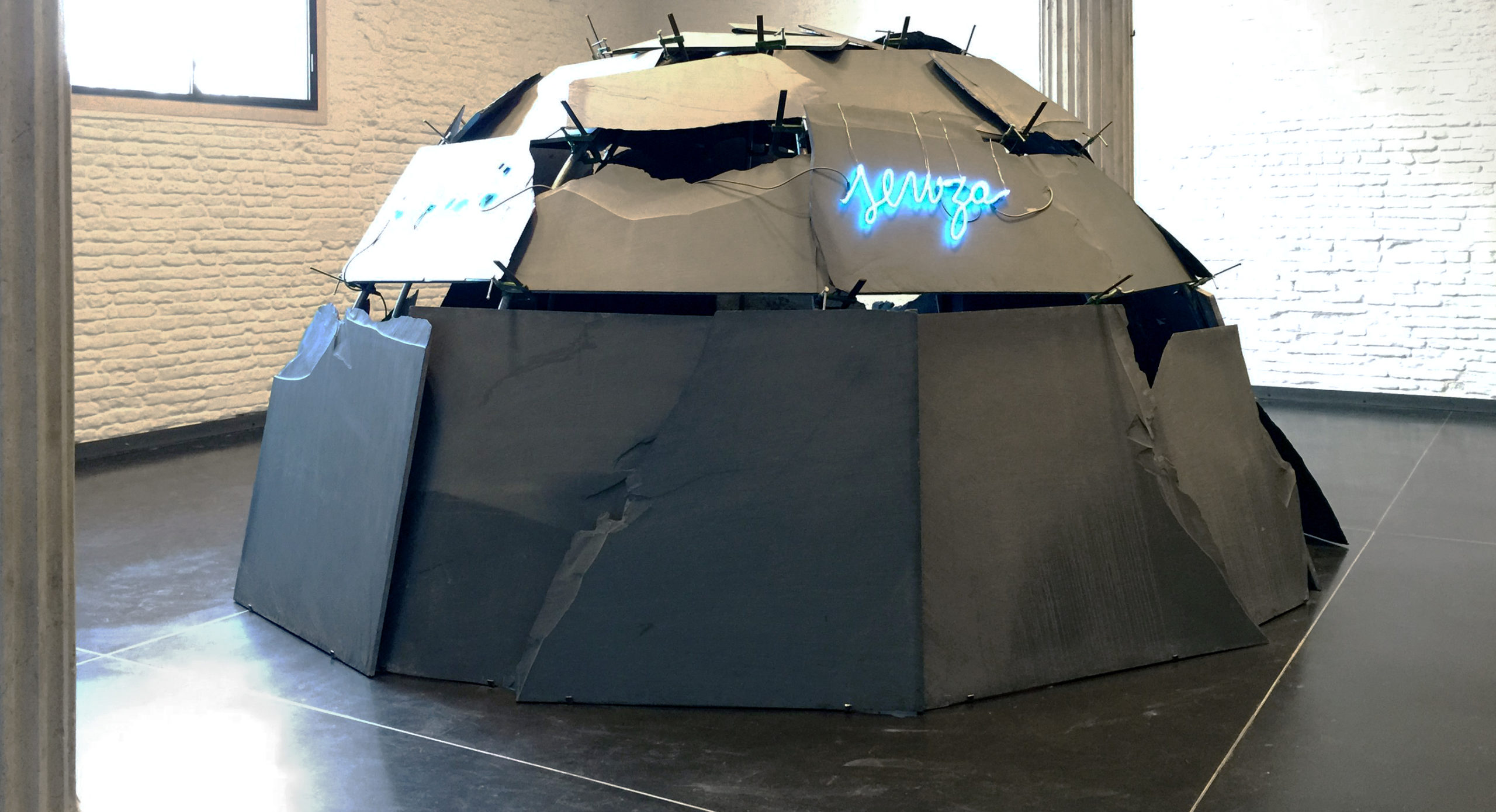
Mario Merz, Luoghi senza strada, 1994, slate, neon, wire (photo: Giovanni Sighele, CC BY 2.0)
At first glance, General Giáp’s quote might not seem relevant to an igloo made of wire and clay, but the clay-filled bags are reminiscent of sandbags used in bunkers during war and have a defensive appearance. Art historian Elizabeth Mangini has proposed that the bags of clay are suggestive of General Giáp’s statement—the clay might provide strength in its structure, but it covers much less ground than it would if the clay was spread out.
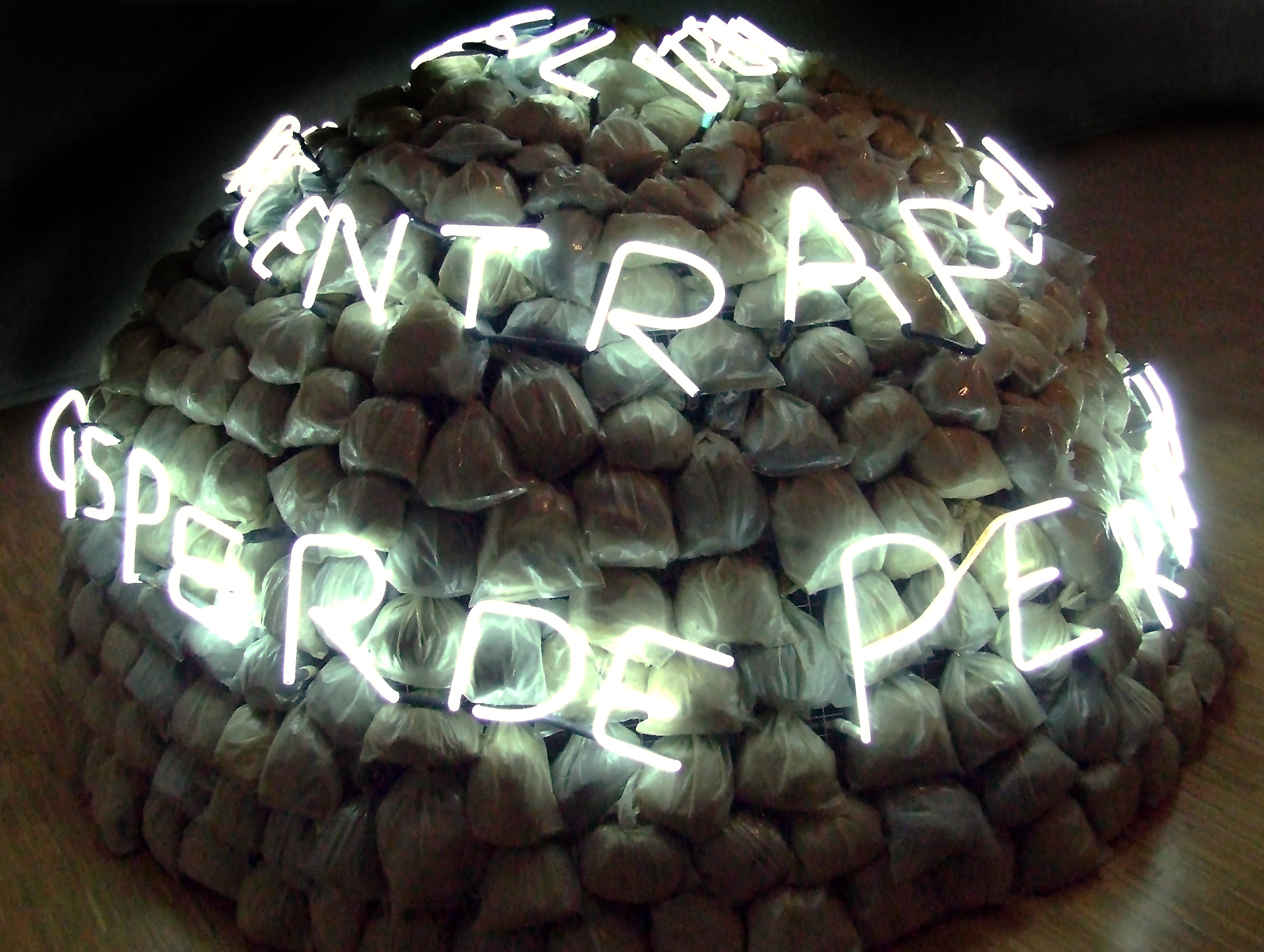
Mario Merz, Igloo di Giap (Giap’s Igloo), 1968, metal structure, wire mesh, bags of clay soil, neon, batteries, accumulators, 120 x 200 cm (Centre Georges Pompidou, Paris)
Viewers engage with Giáp’s Igloo as they walk multiple times around it to read the neon text. Art historian Carolyn Christov-Bakargiev has suggested that the viewer’s involvement with the work mirrors Giáp’s words. When reading the first half of the quote that begins at the top of the igloo, viewers must walk slowly for a short distance around the igloo to read the phrase and so cover little ground. The second half of the quote is spread out across the lower half of the igloo and causes the viewer to walk much more quickly to read all the text and therefore scatters and loses strength.
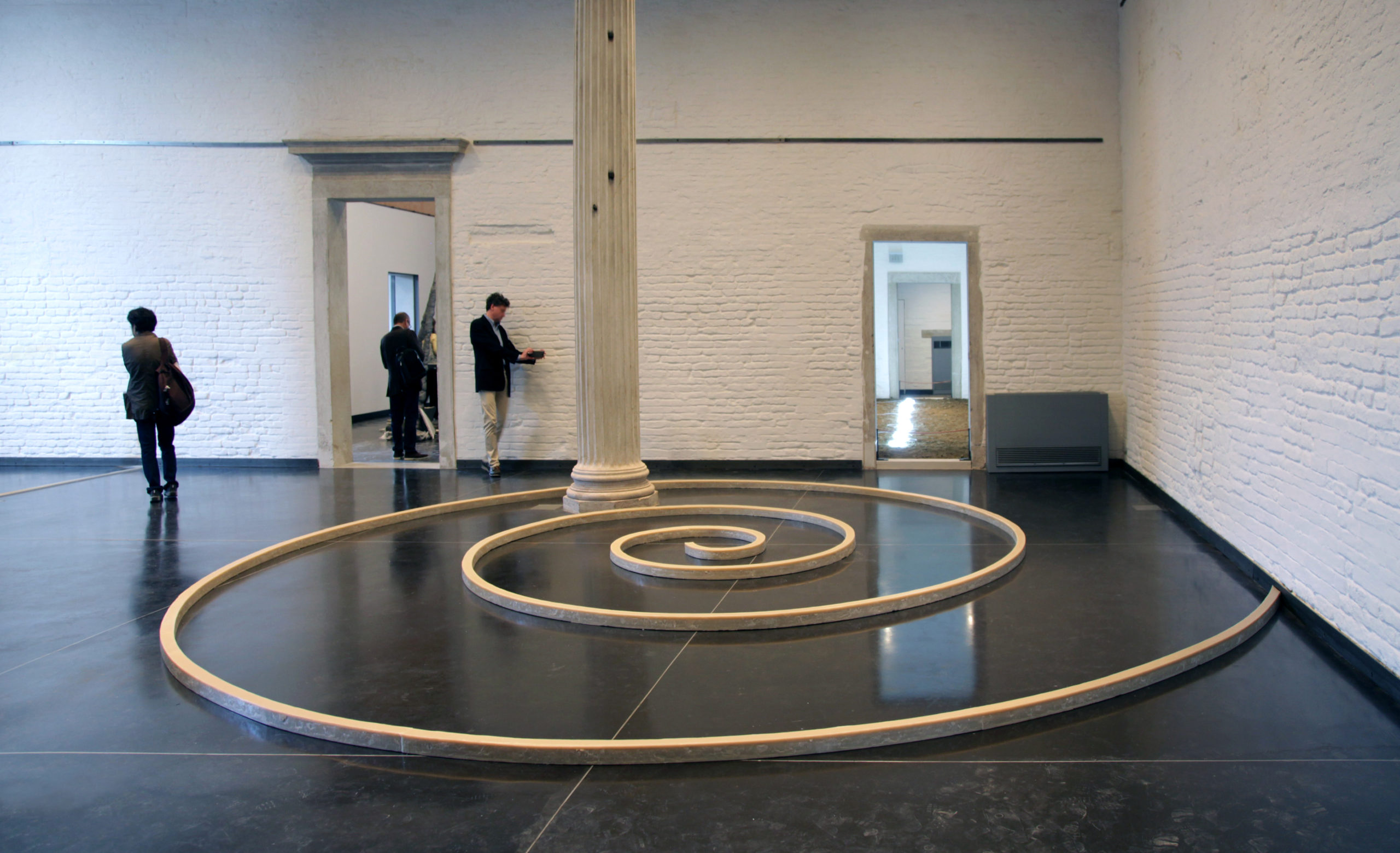
Mario Merz, Spirale di cera, 1970–81 (photo: Giovanni Sighele, CC BY 2.0)
The Fibonacci sequence
Requiring the viewer to expend energy to understand Giap’s Igloo is closely tied to Merz’s interest in conveying the presence of underlying invisible energies present in life. [1] The igloo’s shape is, for Merz, a metaphor for this energy. Merz was drawn to the igloo because he saw within its design, a spiraling line that begins at the structure’s apex and slowly spreads outward to its base. Merz’s fascination with the spiral motif as an expression of the expansion of energy into space is closely tied to the artist’s interest in the Fibonacci sequence, which he incorporated in different ways throughout his artmaking.
Named after the 13th-century Italian mathematician, Leonardo of Pisa (later known as Fibonacci), this famous mathematical series consists of a sequence of numbers in which each is the sum of the two proceeding numerals: 0, 1, 1, 2, 3, 5, 8, 13, 21, etc. and produced, for example, by 0+1=1, 1+1=2, 1+2=3, 2+3=5 and so on. This increasing mathematical sequence can be found in biological growth patterns, such as how certain flowers produce petals or the family tree of honeybees. When the Fibonacci sequence is drawn out in a diagram, it represents an ever-expanding spiral. For Merz, the Fibonacci series illustrates how everything, from nature to society, is in a transformative state of progression and change.
The Fibonacci sequence is implicit within Giap’s Igloo. The artwork turns out to be not just a simple structure made of humble materials, but a multifaceted dialogue with the past, present, and future. Its shape harkens back to the past, the written statement speaks to the contemporary actions of humanity, and the essential form contains within it the mathematical expression of how the future will continue to develop and transform. When encountering Giap’s Igloo, Merz invites you to consider your actions, and how those actions will contribute to our larger existence.

